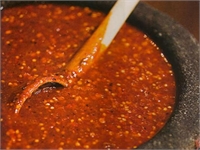
Medium-Hot Cooked Red Salsa
Important Notice: Our web hosting provider recently started charging us for additional visits, which was unexpected. In response, we're seeking donations. Depending on the situation, we may explore different monetization options for our Community and Expert Contributors. It's crucial to provide more returns for their expertise and offer more Expert Validated Answers or AI Validated Answers. Learn more about our hosting issue here.

Medium-Hot Cooked Red Salsa
You must be logged in to post a comment.
Do you love an excellent hot salsa, one that accentuates the flavor of good Mexican or other Latin-American food without burning to a degree that you can no longer taste the food? I have had chunky salsas, watery salsas, many variations of green and red salsa; some were very good with tortilla chips; some of the milder salsa verdes were good with less spicy Mexican dishes. However, when I have a burrito or taco I want a nice bite to it, but I don’t want to be overpowered. Most of us who like spicy food prefer a medium-hot salsa, and this recipe fits the bill perfectly.
Unlike most salsa recipes, this is a cooked, pureed salsa, so it takes some time to prepare, but it is very much worth it, and the leftover (there will be leftover salsa) freezes and thaws well and can last in the freezer for a year, maybe more. If you want to make the salsa milder, cut down on how many Japanese chilies you use; to make it hotter, add a couple Serrano (of if you like it really hot, habañero) peppers to the mix.
It may seem odd that Japanese chilies are the main ingredient for an “authentic” Mexican salsa, but I swear that the guy who gave me a version of this recipe was Mexican through and through. These peppers have a nice kick—unlike jalapenos, whose heat comes on slowly and lasts forever—but the burn fades rapidly.
This recipe will yield about 3 quarts of one of the best pureed red salsas you’ve ever had.
For this, you will need:
Procedure:
I like my red salsa a little on the runny side, so you may want to add more water in the end. After adding the water, taste it and adjust the salt-bouillon-lime if needed.